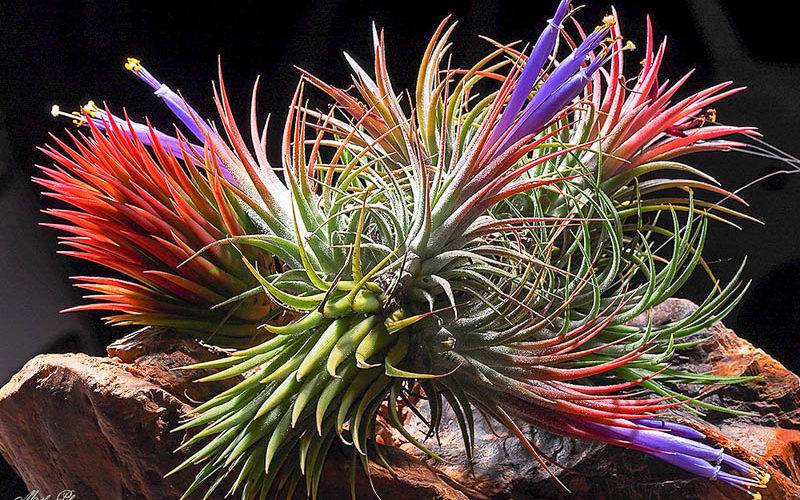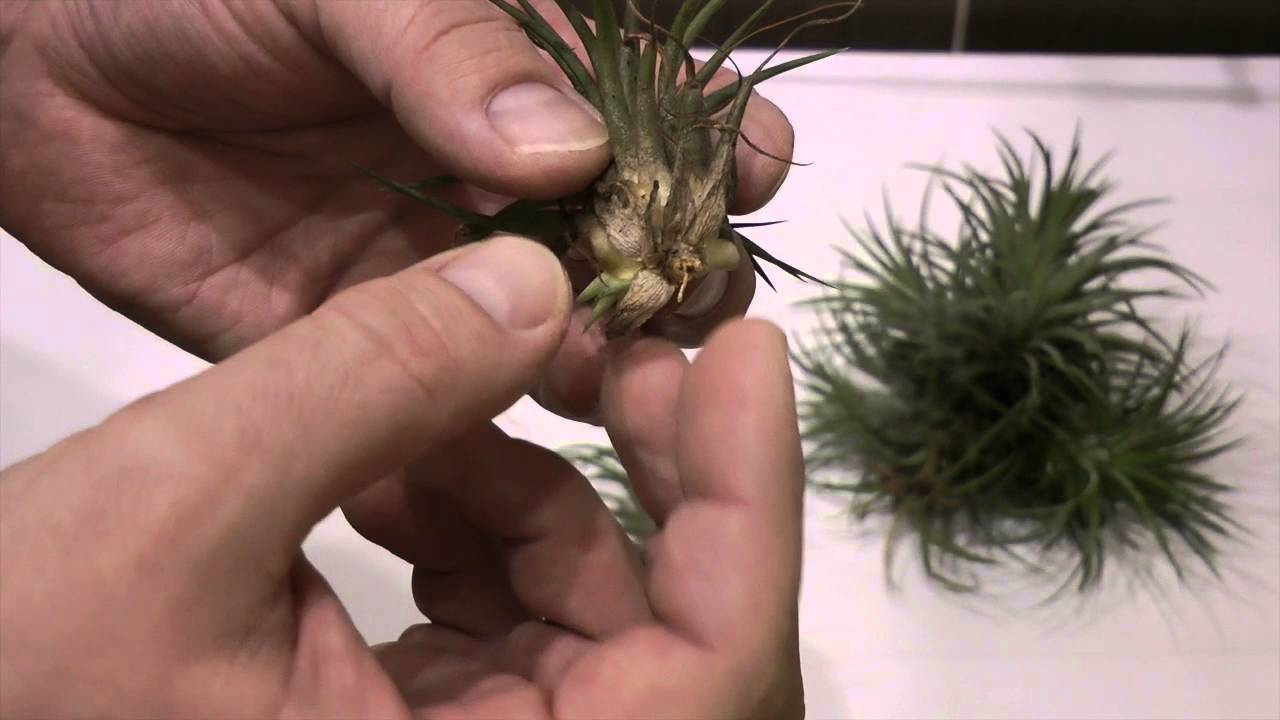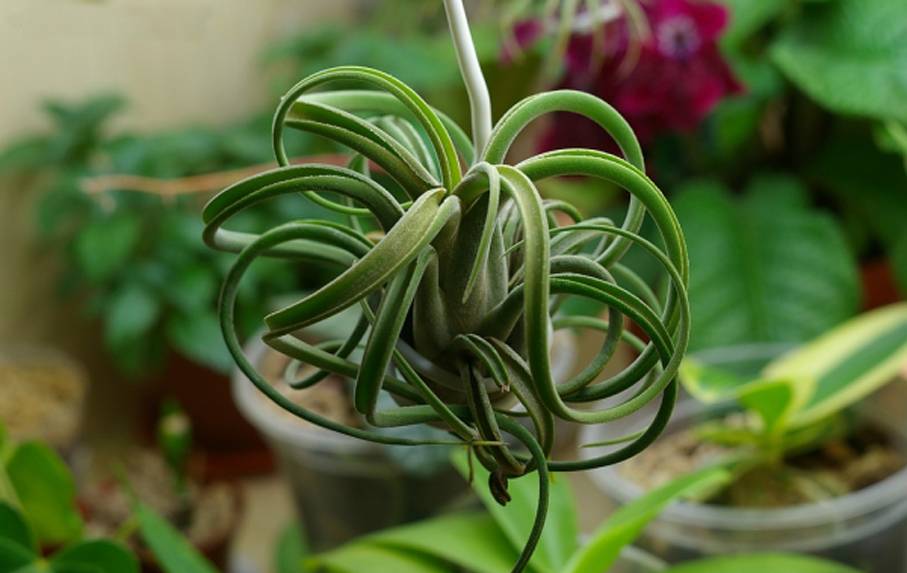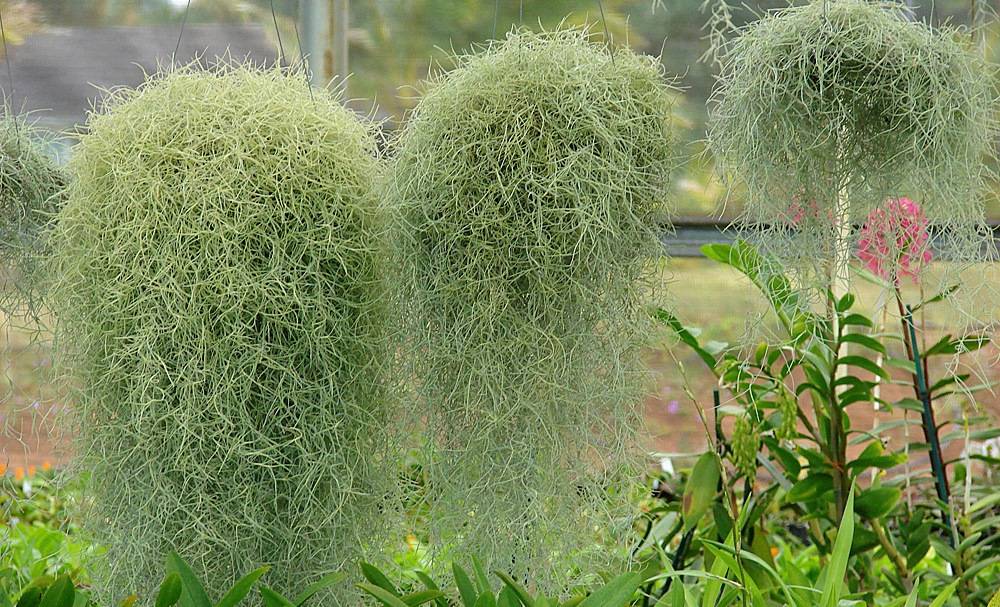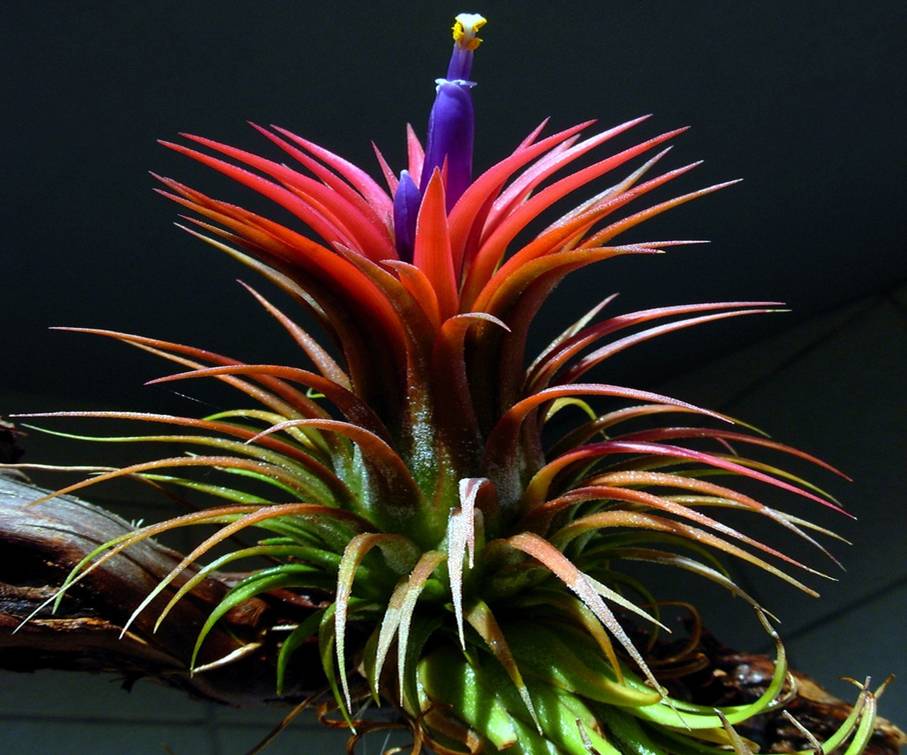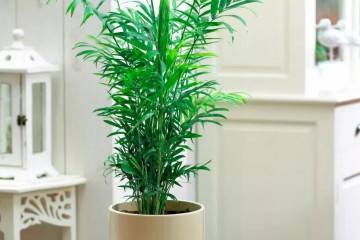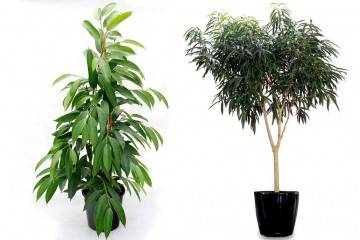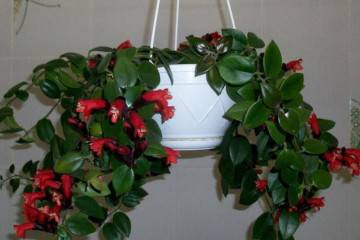Tillandsia flower - home care
Content:
Lovers of exotic indoor flowers cannot pass by tillandsia, which usually becomes the center of attention in the interior of a room. The flower brings together many unusual scenic views. Demanding care does not prevent it from being highly popular with flower growers.
What does it look like, which family it belongs to
Tillandsia is a herbaceous perennial plant from the Bromeliad family, uniting up to 500 varieties, which at first glance do not look at all like related forms.
All of these flowers are usually divided into two large groups:
- Terrestrial (green) with a shortened hard stem, a compact bright green rosette and an impressive formed root system. Smooth foliage, elongated or triangular, 30 to 40 cm long and 3-5 cm wide;
- Atmospheric (gray) belongs to epiphytes that use other plants as support. Their distinctive feature is the absence of a stem and the presence of aerial roots. The narrow, elongated foliage is greenish-gray or silvery-olive in color. From above it is covered with small growths, with the help of which the plant receives nutrients and moisture from the air.
Homeland of the plant
The variety of Tillandsia species is due to its origin. In nature, the flower is common in South and Central America: in Mexico, Argentina, Chile, USA. Most often it occurs:
- in the mountains;
- in semi-deserts;
- in the savannahs;
- along the banks of rivers;
- in wet forests;
He had to adapt to all kinds of weather and climate, which was reflected in his appearance.
Briefly about the history of appearance
The plant got its modern name in the middle of the 18th century after the name of the Swedish scientist E. Tillands who described it. Among the American natives, it had very artistic names:
- angel hair;
- senile beard;
- Spanish (Louisiana) moss.
K. Linnaeus considered these terms barbaric and renamed the flower.
Features of home care
The creation of conditions for growing tillandsia depends on its variety. Green and atmospheric species equally require ventilation, but they do not tolerate drafts well.
Temperature
The thermal regime must be the same for both forms, it must be maintained:
- in summer, the plant is comfortable at t from 20 to 28 degrees;
- in winter - at 15-18 degrees.
Experts advise to take out the pot on the balcony in the summer. The night temperature may be slightly lower, but the plant will not like the sudden drop.
Lighting
The plant is light-loving, but does not like direct sunlight. The atmospheric variety prefers slightly shaded areas, while diffused lighting is more suitable for the green. The best placement in the room for them is the east or southwest window.
Watering and spraying
Tillandsia flower needs abundant irrigation, especially in summer. The soil in potted species should always be moist. Due to the lack of a root system in atmospheric flowers, they receive nutrition from the surrounding air. Moisturizing is produced by:
- completely immersed in water;
- sprinkling generously;
- pouring from the shower;
- pouring settled water inside the sheet sockets.
In the summer, watering is carried out every day, in winter and autumn - depending on the temperature. Water for irrigation and spraying should be taken settled. The plant instantly responds to the lack of water with drooping leaves twisted into tubes. You can fix the situation by placing the pot in a container of water for several hours.
Humidity
For comfortable growth and development of tillandsia, which receives nutrition in a non-standard way, it requires an increased moisture content in the air. For this purpose, experienced florists use special florariums, which allow them to maintain the desired degree of moisture - above 65-80%.
Priming
Perfect for both types of flower ready-made store substrate for orchids. Prepare it on their own, mixing in a ratio of 4x1x1x1:
- leafy ground;
- crushed peat;
- crushed sphagnum moss;
- river sand.
Top dressing
Due to the nature of cultivation, fertilizers should not be applied directly to the soil, so as not to injure the roots. Tillandsia grows slowly and requires a minimum of feeding, mainly during the growing season. Atmospheric species are provided with nutrients by the bark on which they grow. Rosette varieties are fertilized every 2-4 weeks with complex minerals for orchids, diluted 2 times.
Top dressing is carried out by immersion or spraying.
When and how it dissolves
Tillandsia's life ends after flowering. After the completion of the formation of daughter inflorescences, the maternal rosette dies off, from the center of which bracts grow, similar in shape to a spikelet or oar. Flowers bloom from them with narrow, curved petals of bright color.
Usually, the flowering period occurs in the summer, but various reasons can affect the time when the flower stalks are laid. For two months, the owner can admire the exquisite flower.
Pruning
The plant does not need to form a crown: it does not have an excess of branches and foliage. Only a dried peduncle is removed, but experts do not advise getting rid of it, but continuing to care for Tillandsia. Young rosettes will appear on the peduncle, which are left to grow in the old place until they turn into new tillandsia. Alternatively, they are cut from the bush and planted in separate pots.
How does it multiply
Before proceeding with this procedure, you should familiarize yourself with the features of tillandsia, find out how it reproduces. New flowers are grown in two ways: using seeds and lateral shoots.
Children
This method is the most common and simplest one. Young shoots (from 3 to 8 rosettes) quickly start growing at the end of flowering. If they are not divided, the bush begins to grow in width. For transplantation, they are accepted when the children reach a size of 6 to 8 cm, and they have roots. Reproduction of epiphytes is even easier. The bush is simply divided into pieces and placed in prepared bases with raw moss.
Seed propagation
Using seeds is unproductive: they often get lost in coarse soil or rot in shallow soil. Experts advise spreading them evenly over wet orchid soil and covering them with foil, creating a greenhouse effect. Seedlings will appear in a month.
Transfer
Tillandsia should be transplanted into a more nutritious substrate only if purchased in a store, if it does not have a peduncle. The rosettes formed after flowering are transplanted.
The volume of the flowerpot should correspond to the size of the roots - be wide and small.It is filled with a mixture of pieces of bark and natural granules with the addition of coconut fiber and river stones. Atmospheric plants are attached with an elastic, easily removable tape to a small surface. Suitable for them:
- fragments of wooden materials;
- pieces of driftwood for tillandsia;
- coconut fiber;
- felt material.
The flower is placed in a flat pot.
Possible growing problems
In addition to insects and infection, the culprit for the loss of the beauty of a flower is most often errors in care. Providing favorable conditions avoids growing complications.
Pests
Weakened plants can be attacked by:
- scale insects;
- whitefly;
- mealybugs;
- aphids.
Ladybugs help to cope with harmful insects. To do this, the plant must be taken out into the air. Moreover:
- cut off damaged leaves;
- thin out plants;
- washed foliage with soapy water;
- wash off small pests with a strong stream of water;
- use insecticidal preparations.
At low room temperatures and excessive humidity, epiphytes are prone to fungal and viral infections. The problem is revealed in appearance: the foliage becomes transparent, dark spots appear on it. The plant is treated with fungicides.
Other problems
Errors in grooming cause a transformation in the appearance of tillandsia. The color changes and the elasticity of the foliage is lost, the growth of the plant slows down, the leaves fall as a result:
- sharp temperature changes;
- draft;
- shortage or excess of lighting;
- excess or deficiency of moisture.
Compliance with an impeccable breeding regime will preserve the decorative effect of the plant.
Views
In a natural setting, there are approximately 400 species. Usneiform tillandsia is traditionally grown, which can be taken care of at home even by amateurs.
Atmospheric
Usually they are bred in florariums. They do not need soil. This variety includes:
- tillandsia usneoides (tillandsia usneoides, mossy);
- tillandsia jellyfish head (tillandsia caput medusae);
- silvery (hairy);
- tillandsia ionant (violet, ionantha);
- tillandsia Houston Cotton Candy;
- Flabellata.
Potted
Green flowers are in demand due to the original spike-shaped inflorescences. They are grown in flowerpots, like ordinary houseplants:
- tillandsia blue;
- Linden;
- Duera (Dierianne);
- tillandsia cyanea (tillandsia cyanea);
- Anita (hybrid);
- tillandsia xerographica;
- bulbous (tillandsia bulbosa).
The plant, due to its origin, adapts to any growing conditions. It's easy to look after him. To get a really exquisite and spectacular flower, an amateur must fulfill all the requirements, provide the tillandsia flower with home care, so that it decorates the house and makes the design of the room picturesque and sophisticated.



